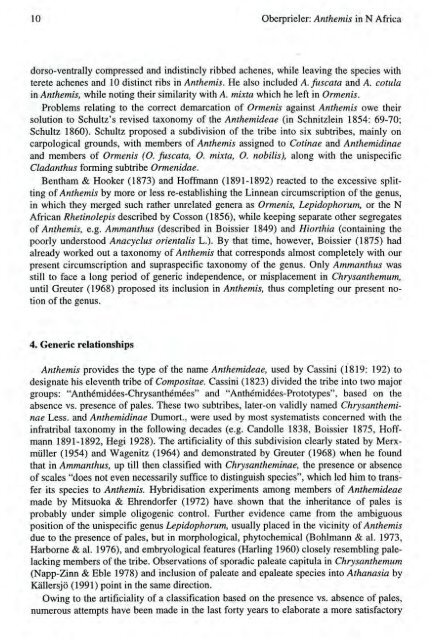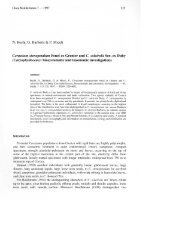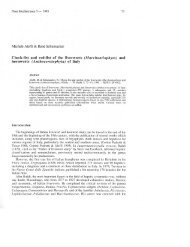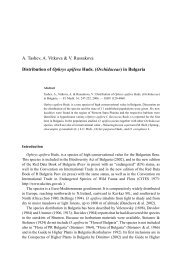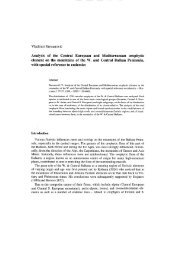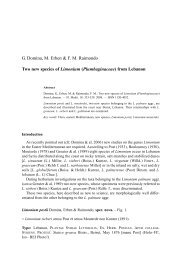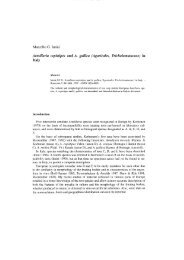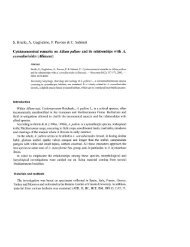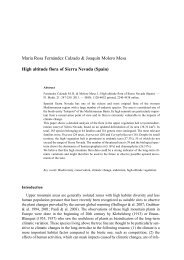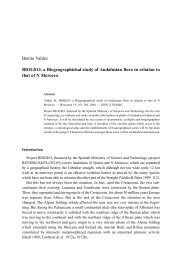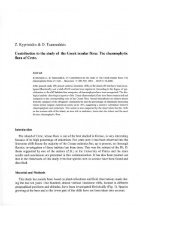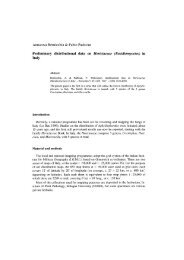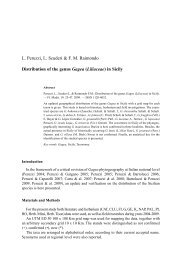Christoph Oberprieler The Systematics of Anthemis L. - Herbmedit.org
Christoph Oberprieler The Systematics of Anthemis L. - Herbmedit.org
Christoph Oberprieler The Systematics of Anthemis L. - Herbmedit.org
Create successful ePaper yourself
Turn your PDF publications into a flip-book with our unique Google optimized e-Paper software.
lO<br />
<strong>Oberprieler</strong>: <strong>Anthemis</strong> in N Africa<br />
dorso-ventralIy compressed and indistinc1y ribbed achenes, while leaving the species with<br />
terete achenes and IO distinct ribs in <strong>Anthemis</strong>. He also inc1uded A. fuseata and A. eotula<br />
in <strong>Anthemis</strong>, while noting their similarity with A. mixta which he left in Ormenis.<br />
Problems relating to the correct demarcation <strong>of</strong> Ormenis against <strong>Anthemis</strong> owe their<br />
solution to Schultz's revised taxonomy <strong>of</strong> the Anthemideae (in Schnitzlein 1854: 69-70;<br />
Schultz 1860). Schultz proposed a subdivision <strong>of</strong> the tribe into six subtribes, mainly on<br />
carpological grounds, with members <strong>of</strong> <strong>Anthemis</strong> assigned to Cotinae and Anthemidinae<br />
and members <strong>of</strong> Ormenis (O. fuseata, O. mixta, O. nobilis), along with the unispecific<br />
Cladanthus forming subtribe Ormenidae.<br />
Bentham & Hooker (1873) and H<strong>of</strong>fmann (1891-1892) reacted to the excessive splitting<br />
<strong>of</strong> <strong>Anthemis</strong> by more or less re-establishing the Linnean circumscription <strong>of</strong> the genus,<br />
in which they merged such rather unrelated genera as Ormenis, Lepidophorum, or the N<br />
African Rhetinolepis described by Cosson (1856), while keeping separate other segregates<br />
<strong>of</strong> <strong>Anthemis</strong>, e.g. Ammanthus (described in Boissier 1849) and Hiorthia (containing the<br />
poorly understood Anaeyclus orientalis L.). By that time, however, Boissier (1875) had<br />
already worked out a taxonomy <strong>of</strong> <strong>Anthemis</strong> that corresponds almost completely with our<br />
present circumscription and supraspecific taxonomy <strong>of</strong> the genus. Only Ammanthus was<br />
stilI to face a long period <strong>of</strong> generic independence, or rnisplacement in Chrysanthemum,<br />
until Greuter (1968) proposed its inc1usion in <strong>Anthemis</strong>, thus completing OUT present notion<br />
<strong>of</strong> the genus.<br />
4. Generic relationships<br />
<strong>Anthemis</strong> provides the type <strong>of</strong> the name Anthemideae, used by Cassini (Ì819: 192) to<br />
designate his eleventh tribe <strong>of</strong> Compositae. Cassini (1823) divided the tribe into two major<br />
groups: "Anthérnidées-Chrysanthémées" and "Anthémidées-Prototypes", based on the<br />
absence vs. presence <strong>of</strong> paleso <strong>The</strong>se two subtribes, later-on validly named Chrysantheminae<br />
Less. and Anthemidinae Dumort., were used by most systematists concerned with the<br />
infratribal taxonomy in the folIowing decades (e.g. Candolle 1838, Boissier 1875, H<strong>of</strong>fmann<br />
1891-1892, Hegi 1928). <strong>The</strong> artificiality <strong>of</strong> this subdivision c1early stated by Merxmiiller<br />
(1954) and Wagenitz (1964) and demonstrated by Greuter (1968) when he found<br />
that in Ammanthus, up till then c1assified with Chrysantheminae, the presence or absence<br />
<strong>of</strong> scales "does not even necessarily suffice to distinguish species", which led him to trans~<br />
fer its species to <strong>Anthemis</strong>. Hybridisation experiments among members <strong>of</strong> Anthemideae<br />
made by Mitsuoka & Ehrendorfer (1972) have shown that the inheritance <strong>of</strong> pales is<br />
probably under simple oligogenic control. Further evidence carne from the ambiguous<br />
position <strong>of</strong> the unispecific genus Lepidophorum, usualIy placed in the vicinity <strong>of</strong> <strong>Anthemis</strong><br />
due to the presence <strong>of</strong> pales, but in morphological, phytochernical (Bohlmann & al. 1973,<br />
Harborne & al. 1976), and embryological features (Harling 1960) c10sely resembling palelacking<br />
members <strong>of</strong> the tribe. Observations <strong>of</strong> sporadic paleate capitula in Chrysanthemum<br />
(Napp-Zinn & Eble 1978) and inc1usion <strong>of</strong> paleate and epaleate species into Athanasia by<br />
KiilIersj6 (1991) point in the same direction.<br />
Owing to the artificiality <strong>of</strong> a c1assification based on the presence vs. absence <strong>of</strong> pales,<br />
numerous attempts have been made in the last forty years to elaborate a more satisfactory


